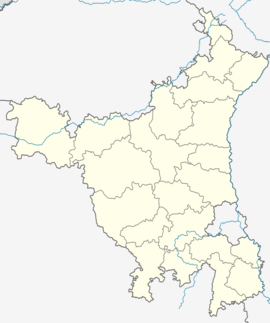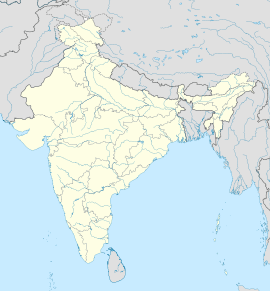Banawali facts for kids
| Location | Baguwali, Haryana, India |
|---|---|
| Coordinates | 29°35′54″N 75°23′31″E / 29.59833°N 75.39194°E |
| Type | Settlement |
| History | |
| Periods | Harappan 3A to Harappan 5 |
| Cultures | Indus Valley civilization |
| Site notes | |
| Archaeologists | R. S. Bisht |
Banawali is an ancient archaeological site in Haryana, India. It belongs to the amazing Indus Valley civilization. This site is about 120 kilometers northeast of Kalibangan. It is also 16 kilometers from Fatehabad.
Banawali used to be called Vanavali. It sits on the left bank of the dried-up Sarasvati River. While Kalibangan was in the lower part of the river valley, Banawali was built in the upper middle part.
Contents
Discovering Banawali: The Excavation Story
Archaeologists started digging at Banawali in 1974. R.S. Bisht from the Archaeological Survey of India led this important work. They found different layers of history, showing how the site changed over time.
Early Settlements: Period I (around 2500-2300 BCE)
The oldest part of Banawali is called Period I. During this time, people built well-planned houses. They used bricks that were baked in a kiln or shaped by hand. The pottery they made was similar to what was found at Kalibangan from the same time.
The Main Harappan City: Period II (around 2300-1700 BCE)
This was when Banawali became a strong, planned city. People built a huge defense wall. It was over 105 meters long, 4.5 meters high, and 6 meters wide. The city itself was like a chessboard, measuring 200 by 500 meters.
The city had two main areas. One part was likely for the rulers. The other part was for everyone else. In the common people's area, houses were built along straight streets. These streets ran north-south and were crossed by east-west lanes. This shows it was a very organized city.
Houses had floors made of packed earth and walls covered in mud plaster. They had rooms, kitchens, and even toilets. Many houses also had special storage areas.
Later Times: Period III (around 1700-1500/1450 BCE)
After the main Harappan period, a culture called the Bara culture lived here. This period is known as Post-Harappan or Late Harappan.
Amazing Architecture and Homes
The excavations showed that Banawali was a well-built fort town. It was constructed on top of an even older settlement. The strong defense wall protected the city.
The houses were very well planned. They had packed earth floors, rooms, and toilets. People built their homes on both sides of the streets and lanes.
Archaeologists found a set of steps near the southeast part of the city's defenses. These steps went from the 'Lower Town' up to a higher area called the Acropolis. This was an important discovery.
What We Learned from the Houses
Some houses gave us clues about the people who lived there. In one house with many rooms, a kitchen, and a toilet, archaeologists found seals and weights. This suggests the owner might have been a merchant.
Another larger house had many gold beads, shiny lapis lazuli, and carnelian stones. Tiny weights and a special 'touchstone' with gold streaks were also found. This tells us the house likely belonged to a jeweler or someone who made ornaments.
Many houses in Banawali also had evidence of fire altars. These altars were often found with special curved structures. This suggests people used them for religious ceremonies.
Cool Artefacts Found at Banawali
Archaeologists found many interesting items at Banawali. These include S-shaped jars, cooking pots, ovens, and tandoors (clay ovens). They also found painted earthen pots. The paintings showed peacocks, pipal leaves, trees, deer, stars, fish, flowers, and cool patterns like intersecting circles and checkerboards.
They also discovered Harappan seals. These seals had pictures of animals like rhinoceroses, wild goats, ibex, and even mythical creatures. Gold, copper, and bronze pieces were found, along with gold beads and shell bangles. The pottery found here is very fine and similar to the pottery from Kalibangan I.
Important Discoveries
Two very important finds were made in 1987-88:
- A special grey pot was found. It had two bull-head designs on it. These designs are similar to bull heads seen on older pots from other sites like Kot-Diji and Kalibangan.
- An unbaked clay figure of an animal was discovered. It had deep criss-cross cuts on its back and neck. These cuts made it look like a horse, possibly showing a saddle and mane.
Other finds include an ivory comb, a clay cake with an engraved donkey, and human figures. They also found a tortoise shell and many items made of gold and silver.
Why Banawali Declined
The busy city life at Banawali, and also at Kalibangan, seemed to end quite suddenly. Archaeologists are still studying why this happened.
More Interesting Facts
The bricks used in early Banawali had a size ratio of 3:2:1. Later bricks had a different ratio of 4:2:1. One weight found here weighed 87.855 grams. This is about 100 times heavier than a common weight found in Harappa.
The wall around Banawali was probably built to protect against floods from the Sarasvati River. It seems the wall eventually collapsed due to water damage. Marine shells were found at Banawali, even though it's far from the sea. This suggests that people traded goods between different regions during the early Indus period.
Seals were only found in the lower town, not in the citadel (the higher, fortified part). Many small stone weights and a clay model of a plough were also found. A large number of female figurines were discovered here, similar to those found at Mohenjo-daro and Harappa.
A special 'touchstone' with gold streaks was found. This stone was likely used to test how pure gold was. This is a technique that is still used today!
Most of the items found at Banawali have been reburied to protect them. However, a well from the Harappan era has been carefully preserved. It stands as a reminder of how old and important this village is.
See also
- Indus Valley civilization related
- List of Indus Valley Civilization sites
- Bhirrana, an IVC site with very early dates
- Kalibanga, another important IVC town and fort
- Rakhigarhi, one of the largest IVC cities
- Kunal, an ancient cultural site
- List of inventions and discoveries of the Indus Valley Civilization
- Periodisation of the Indus Valley civilisation
- Pottery in the Indian subcontinent
- Bara culture, a type of Late-Harappan pottery
- Cemetery H culture, early pottery found at IVC sites
- Black and red ware, pottery from early periods
- Sothi-Siswal culture, a type of Early-Harappan pottery
- List of Indus Valley Civilization sites
- History of Haryana



